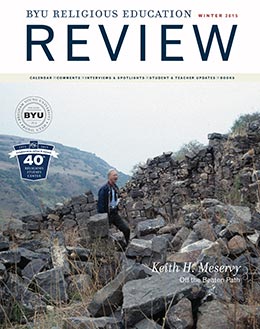Welcome to another edition of the Review magazine. This issue is the first of two editions during the RSC’s fortieth anniversary, both of which highlight the important research, outreach efforts, and pedagogical interests and pursuits of the faculty of Religious Education.
In this issue, you will find information on the changing curriculum in Religious Education and what efforts are under way to implement the new curriculum. At the time of this publication, four new courses are in the pilot stage and will be offered in the fall of 2015. Key faculty have been assigned to develop syllabi, learning outcomes, and goals for the new courses and the new offerings in the fall will give us our first significant glimpse into the new curriculum and how it will be implemented and received.
Of additional interest in this issue is a timely and important discussion of Latter-day Saint women in the three decades after the Equal Rights Amendment was passed. In the article, J. B. Haws addresses the difficult topic of breaking down the myth that Mormonism is a monolithic entity with a single voice on the role of women in the Church. He highlights some of the important moments in the discussion as well as drawing attention to milestone publications and points of interest.
Among the many other gems in the issue is an interview with Religious Education’s Matthew O. Richardson, who recently began serving as advancement vice president under President Kevin J Worthen. In the interview, Professor Richardson describes his new assignments, some of the directions that he sees in moving forward, and some of the challenges he is facing. Through it all, Professor Richardson shares his own unique perspective that he brings to the job and how that has shaped his work and his approach to working with student athletes and faculty.
Professor Michael A. Goodman, as one of the coordinators and organizers of the conference “The International Church,” offers a perspective on the growing global identity of the Church and he addresses some of the important challenges we face in going forward. Specifically, he discusses issues associated with cultural diversity, regional politics, and religious influences. Tellingly, Goodman notes that the international Church has grown over 600 percent during a thirty-year period, a number that is certainly indicative of powerful trends—such as a shifting identity and unforeseen challenges.
I hope you enjoy reading about the research and achievements of the faculty of Religious Education, particularly in their outreach to a wider audience and their efforts to spread the good news of the faith. It is comforting to write from a position where I am able to access and share in the exciting work that is being done.
Thomas A. Wayment
Publications Director
Religious Studies Center
